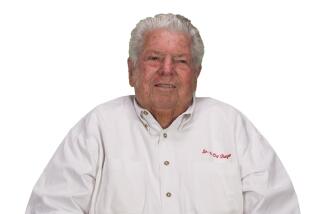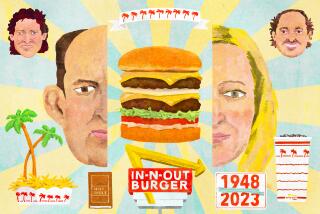Signature Exhibit at Reagan Library
- Share via
Thanks to the generosity of the co-founder of In-N-Out Burger, the Ronald Reagan Presidential Library and Museum near Simi Valley today will unveil its newest permanent exhibit: a rare, 1823 parchment copy of the Declaration of Independence.
“This is an extraordinary historical document,” said library director Duke Blackwood, who will unveil the Declaration during a public ceremony at 11:30 a.m. “We always refer to this as the birth certificate of the United States.”
It was on this date in 1776 that John Hancock became the first person to sign this version of the Declaration. It is the most commonly seen reproduction and the one the public relates to most because, unlike those printed on July 4, 1776, it carries the signatures of 56 delegates to the Continental Congress, Blackwood said.
In 1820, Secretary of State John Quincy Adams commissioned William J. Stone of Washington to create the copies because the signed Declaration was rapidly deteriorating. It took Stone three years to engrave the copper plate. From it, 201 parchment copies were made and distributed to surviving signers of the Declaration, government officials and various universities. Of those, 30 are known to exist today, Blackwood said.
Esther Snyder, president of In-N-Out Burger, donated her copy to the library in memory of her husband, Harry, and the couple’s sons, Rich and Guy.
Harry and Esther Snyder founded In-N-Out Burger in Baldwin Park in 1948. Harry Snyder died of cancer in 1976, Rich died in a plane crash in 1993 and Guy died of a drug overdose in 1999.
Blackwood said Esther Snyder offered the document to the library when she heard that a 1776 copy of the Declaration, which was on temporary exhibit last year, would be leaving in January. Also, Blackwood said, the Snyder family was particularly fond of Reagan.
Thomas Jefferson wrote the Declaration of Independence, asserting that “all men are created equal,” to explain why the colonies had declared their independence from England on July 2, 1776. The Continental Congress adopted Jefferson’s declaration on July 4, 1776, with New York the only holdout among the 13 colonies.
“This had never been done before in the world, saying we are going to govern ourselves,” Blackwood said.
“It’s a declaration of war. It’s basically them thumbing their noses at King George.”
After New York finally agreed to the Declaration on July 9, Congress ordered that it be written formally in large, clear letters and signed by every member, according to the National Archives. Only a few delegates refused. That original Declaration is in the National Archives in Washington.
The Stone copies are easier to read than the original, largely because the wet-ink transfer process the engraver used removed much of the ink from the original, Blackwood said.
Blackwood also hopes to acquire copies of the Constitution and the Bill of Rights, and display together the three documents that form the basis for America’s democracy. Blackwood plans to travel to New York next week in an effort to obtain a 1789 copy of the Constitution.
The Declaration is behind glass, and the temperature and humidity around it are regulated for optimal preservation, Blackwood said. The lighting is dim so as not to fade it.
The Declaration is the cornerstone of the Gallery of Presidents, a new hall dedicated to the history of the country and presidency.
The walls are decorated with portraits of each president, which are reproductions from the White House Historical Assn. collection.
Blackwood said the Declaration is part of the library’s effort to fill schools’ needs.
He said the 1776 copy of the Declaration and the rest of the Freedom’s Journey exhibit last year were so popular that the library began opening early for schools and double-booking field trips. An earlier exhibit of an 1848 copy of the Declaration on rice paper was also successful, Blackwood said.
Jim Sargent, a history teacher at Foothill Technology High School in Ventura, said it’s hard to get teenagers excited about a document. But along with stories about the founding fathers, he said, the copy could help make a trip to the library worthwhile, particularly during this period of renewed patriotism.
“It’s a good spark to get people going,” Sargent said.
More to Read
Sign up for Essential California
The most important California stories and recommendations in your inbox every morning.
You may occasionally receive promotional content from the Los Angeles Times.









